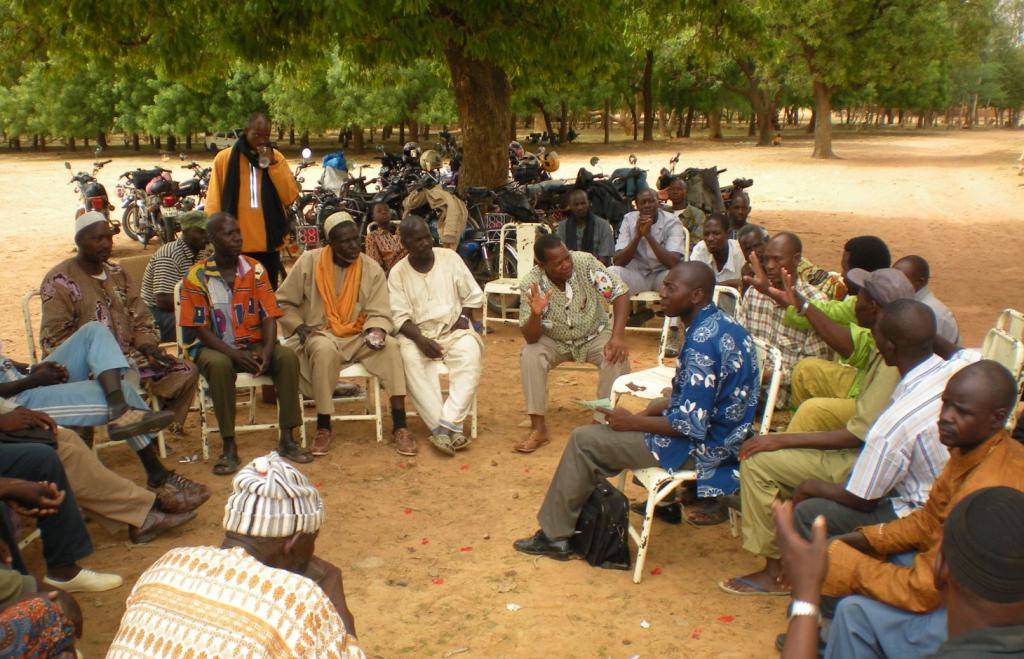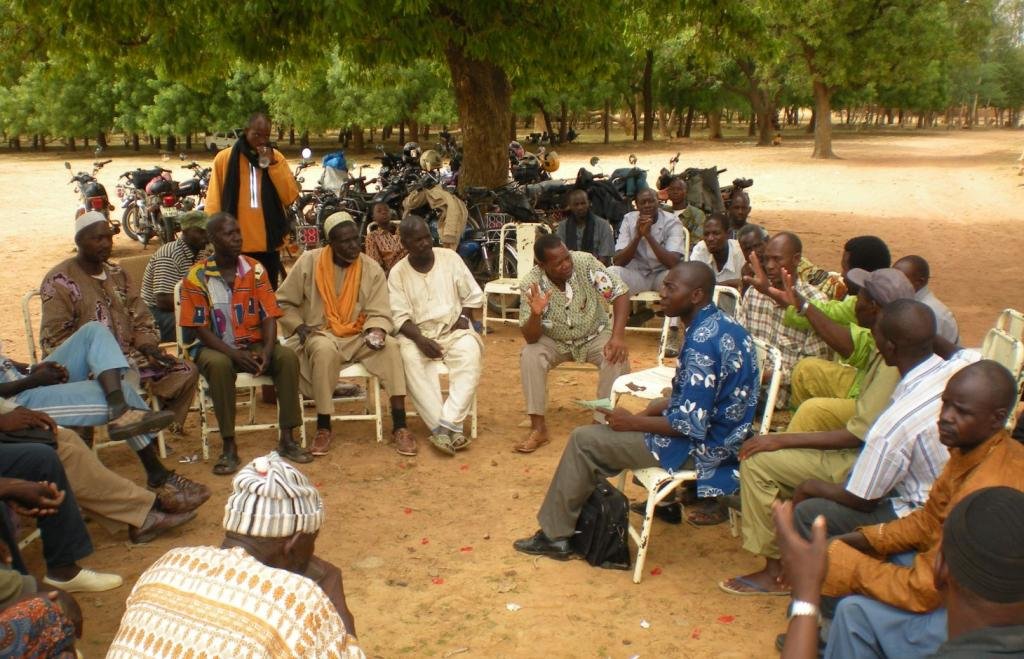Local agreements on the management of small-scale irrigation facilities [马里]
- 创建:
- 更新:
- 编制者: Dieter Nill
- 编辑者: –
- 审查者: Laura Ebneter
Convention locale pour la gestion des aménagements hydro-agricoles
approaches_2504 - 马里
查看章节
全部展开 全部收起1. 一般信息
1.2 参与方法评估和文件编制的资源人员和机构的联系方式
SLM专业人员:
Mushinzimana Godihald
godihald.mushinzimana@giz.de
Deutsche Gesellschaft für Internationale Zusammenarbeit (GIZ)
马里
有助于对方法进行记录/评估的项目名称(如相关)
Programme for Territorial Communities, Mali (PACT)有助于对方法进行记录/评估的机构名称(如相关)
Deutsche Gesellschaft für Internationale Zusammenarbeit (GIZ) GmbH (GIZ) - 德国1.3 关于使用通过WOCAT记录的数据的条件
(现场)数据是什么时候汇编的?:
01/07/2012
编制者和关键资源人员接受有关使用通过WOCAT记录数据的条件。:
是
2. SLM方法的描述
2.1 该方法的简要说明
Local agreements aim to prevent and consensually manage conflicts on a site and to manage natural resources to ensure they are used rationally and sustainably.
2.2 该方法的详细说明
该方法的详细说明:
A local agreement is a mutual agreement covering the ways in which shared natural resources are exploited in order to ensure their fair and sustainable use. As the national methodological guide puts it: ‘All agreements, written or otherwise, between two or more local actors and particularly social groups (socio-professional groups, village associations or communities, or factions), technical services and NGOs set the rules for accessing and using the resources in a way which ensures their conservation and their responsible and sustainable exploitation’.
The local agreement is the fruit of a series of consultation and negotiation forums involving local farmers and managers of a shared natural resource and is delivered with the support of local authorities and their technical services. These consultation and negotiation forums make it possible for all the actors involved to evaluate the status of the resource, identify problems and put forward possible solutions. The forums create a climate of trust among user groups who, despite the difficulties of living side-by-side, remain willing to come together around the same table. The management ideas resulting from the discussions and negotiations are laid down in the form of consensual management rules, collectively called the ‘local agreement’.
Stages of implementation: 1)Information and identification of key actors in the process of drawing up a local agreement. As it is not possible for everyone to participate in the consultation exercise, the process is based on delegation. 2)Natural resource diagnostic exercise: first taking a snapshot of the current state of the resource using tools like resource maps, Venn diagrams and matrices categorizing producers by product. Next, problems arising from resource exploitation and management, and possible solutions to these problems, are identified. 3)The results are fed back to actors who have not been involved in the diagnostic process in order to gather their inputs. 4)Drawing up the draft local agreement: analysing reaction to the diagnostic feedback in order to (i) take on board the most relevant inputs and (ii) flesh out and refine the ideas for regulatory solutions (concrete management rules and their associated sanctions – this constitutes the ‘draft local agreement’) without losing sight of the national legislation relating to the resource. It is during this stage that the mechanism for monitoring the implementation of the agreement is developed. 5)Feedback and validation of the draft: in order to refine the terms of the draft local agreement, the select committee instituted by all those participating in the process feeds back the results of its work and then debates them. Once the terms are agreed by all parties, it is considered validated. 6)The draft local agreement is signed by the local managers of the resource and is then considered by the territorial community and approved by the supervisory authority, where required. Hardcopies of the signed agreement are subsequently given out to key actors and it is disseminated through discussions in general meetings and on local radio. 7)Monitoring bodies are set up to monitor local agreement implementation at the village and commune levels and to deliver training on the roles and responsibilities required at these levels. 8)Monitoring and evaluation is carried out with regard to the implementation of the local agreement and the functioning of bodies tasked with monitoring the implementation.
Involved actors: Territorial communities, farmers and managers of natural resources, technical services, financial support structure.
2.3 该方法的照片
2.5 采用该方法的国家/地区/地点
国家:
马里
区域/州/省:
Mali
有关地点的进一步说明:
Sikasso, Mopti, Koulikoro, Timbuktu
2.6 该方法的开始和终止日期
注明开始年份:
2004
2.7 方法的类型
- 基于项目/方案
2.8 该方法的主要目的/目标
The Approach focused mainly on SLM with other activities
Agreements between different actors on the sustainable and fair use of shared natural resources, reduction of conflicts
The SLM Approach addressed the following problems: conflicts on and unsustainable use of natural resources
2.9 推动或妨碍实施本办法所适用的技术的条件
机构设置
- 阻碍
conflicts and missing agreement on sustainable use of natural resources
Treatment through the SLM Approach: A local agreement is a mutual agreement covering the ways in which shared natural resources are exploited in order to ensure their fair and sustainable use. All agreements between two or more local actors and particularly social groups (socio-professional groups, village associations or communities, or factions), technical services and NGOs set the rules for accessing and using the resources in a way which ensures their conservation and their responsible and sustainable exploitation’.
3. 相关利益相关者的参与和角色
3.1 该方法涉及的利益相关者及其职责
- 当地土地使用者/当地社区
- SLM专家/农业顾问
- 国家政府(规划者、决策者)
- 国际组织
3.2 当地土地使用者/当地社区参与该方法的不同阶段
| 当地土地使用者/当地社区的参与 | 指定参与人员并描述活动 | |
|---|---|---|
| 启动/动机 | 互动 | |
| 计划 | 互动 | |
| 实施 | 互动 | |
| 监测/评估 | 互动 | |
| Research | 被动 |
3.4 有关SLM技术选择的决策
具体说明谁有权决定选择要实施的技术:
- 主要是土地使用者,由SLM专家提供支持
4. 技术支持、能力建设和知识管理
4.1 能力建设/培训
是否为土地使用者/其他利益相关者提供培训?:
是
明确受训人员:
- 土地使用者
培训形式:
- 公开会议
4.2 咨询服务
土地使用者有权使用咨询服务吗?:
是
说明/注释:
Advisory service is quite adequate to ensure the continuation of land conservation activities
4.3 机构强化(组织发展)
是否通过这种方法建立或加强了机构?:
- 是,适度
具体说明机构的强化或建立程度:
- 本地
具体说明支持类型:
- 财务
- 能力建设/培训
4.4 监测和评估
监测和评估是该方法的一部分吗?:
是
注释:
technical aspects were ad hoc monitored by project staff, land users through observations;
socio-cultural aspects were ad hoc monitored by project staff, land users through observations;
management of Approach aspects were ad hoc monitored by project staff, land users through observations;
bio-physical aspects were ad hoc monitored by None through observations;
There were no changes in the Approach as a result of monitoring and evaluation;
There were no changes in the Technology as a result of monitoring and evaluation;
4.5 研究
研究是该方法的一部分吗?
是
明确话题:
- 社会学
- 经济/市场营销
- 生态学
- 技术
5. 融资和外部物质支持
5.1 该方法中SLM组成部分的年度预算
如果不知道准确的年度预算,请给出一个范围:
- 2,000-10,000
注释(例如主要的资助来源/主要捐助者):
Approach costs were met by the following donors: international: 100.0%
5.2 为土地使用者提供财政/物质支援
土地使用者是否获得实施该技术的财政/物质支持?:
是
5.3 对特定投入的补贴(包括劳动力)
如果土地使用者的劳动力是一项重要的投入,那么是不是:
- 自愿
6. 影响分析和结论性陈述
6.1 方法的影响
该方法是否帮助土地使用者实施和维护SLM技术?:
- 否
- 是,很少
- 是,中等
- 是,支持力度很大
All agreements, written or otherwise, between two or more local actors and particularly social groups (socio-professional groups, village associations or communities, or factions), technical services and NGOs set the rules for accessing and using the resources in a way which ensures their conservation and their responsible and sustainable exploitation.
该方法是否有助于社会和经济弱势群体?:
- 否
- 是,很少
- 是,中等
- 是,支持力度很大
The consultation and negotiation forums make it possible for all the actors involved to evaluate the status of the resource, identify problems and put forward possible solutions.
Did other land users / projects adopt the Approach?
- 否
- 是,很少
- 是,中等
- 是,支持力度很大
Implementation locations: Sikasso, Mopti, Koulikoro, Timbuktu and others. A local agreement for managing natural resources usually applies for between three to five years. At the end of this period, the agreement must be evaluated in order to take account of new developments. PACT has been using these local agreements since 2004.
Did the Approach lead to improved livelihoods / human well-being?
- 否
- 是,很少
- 是,中等
- 是,支持力度很大
The forums create a climate of trust among user groups who, despite the difficulties of living side-by-side, remain willing to come together around the same table.
Did the Approach help to alleviate poverty?
- 否
- 是,很少
- 是,中等
- 是,支持力度很大
6.2 土地使用者实施SLM的主要动机
- 增加生产
- 增加利润(能力),提高成本效益比
6.3 方法活动的可持续性
土地使用者能否维持通过该方法实施的措施(无外部支持的情况下)?:
- 是
若是,请说明如何维持:
A local agreement for managing natural resources usually applies for between three to five years. At the end of this period, the agreement must be evaluated in order to take account of new developments. PACT has been using these local agreements since 2004.
The sustainability of the local agreement depends on the level to which its terms are taken up by those who developed it and who are responsible for implementing it. It also depends on the relevance of the regulatory and technical solutions taken forward for resolving the major issues identified in the diagnostic process.
6.4 该方法的长处/优点
| 编制者或其他关键资源人员认为的长处/优势/机会 |
|---|
| More rational and sustainable exploitation of resources |
| Fairer access to developed lands |
| Consultative management of the shared resource |
| Reduction and prevention of conflicts (How to sustain/ enhance this strength: The diagnostic process must reflect reality, as expressed by the beneficiaries themselves. During the diagnostic process, beneficiaries must be given guidance but must not be directly influenced. The solutions put forward must come from the beneficiaries. There must be continuity in terms of key actor representation. The results from consultation exercises must be fed back into the process. Local authorities, supervisory bodies and technical services must be involved. A set of technical measures must be implemented based on the results of the diagnostic process. These measures must reinforce the management rules.) |
| Local agreements on managing developed lands and facilities are drawn up for the majority of hydro-agricultural schemes (How to sustain/ enhance this strength: There must be a system in place to take action against those breaking the terms of the convention (committees and technical services)) |
6.5 该方法的弱点/缺点以及克服它们的方法
| 编制者或其他关键资源人员认为的弱点/缺点/风险 | 如何克服它们? |
|---|---|
|
Getting remote farmers – such as those in localities outside the scope of the local agreement – to respect the rules laid down in the local agreement can be problematic. |
|
| Once the scheme starts developing lands (increasing yields), new conflicts can arise (jealousy) |
7. 参考和链接
7.1 方法/信息来源
- 实地考察、实地调查
- 与土地使用者的访谈
7.2 参考可用出版物
标题、作者、年份、ISBN:
Manual of Good Practices in Small Scale Irrigation in the Sahel. Experiences from Mali. Published by GIZ in 2014.
可以从哪里获得?成本如何?
http://star-www.giz.de/starweb/giz/pub/servlet.starweb
标题、作者、年份、ISBN:
Guide méthodologique national, élaboration d’une convention locale de gestion des ressources naturelles [National methodological guide – Drawing up a local agreement to manage natural resources], MEA (Ministry of Environment and Sanitation), June 2011
标题、作者、年份、ISBN:
Full-cost accounting of local agreements, PACT, October 2006
标题、作者、年份、ISBN:
www.pact-mali.org
链接和模块
全部展开 全部收起链接
无链接
模块
无模块



